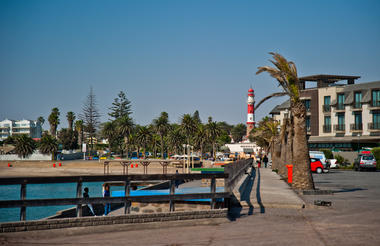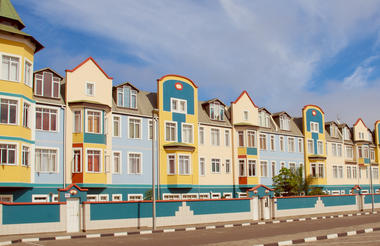With its well-developed infrastructure, some of the best tourist facilities in Africa and an impressive list of breathtaking natural wonders, touring Namibia is truly a pleasure. Visit the capital of Windhoek and the lovely coastal town of Swakopmund to discover remnants of the country’s German influence, reflected in the architecture, culture, cuisine and the annual Oktoberfest celebrations. To properly appreciate this extraordinary country, you will have to venture out of the cities to explore the remarkable natural landscapes Namibia has to offer. These include: the impressive Fish River Canyon Park; the vast Etosha National Park teeming with local subspecies, such as desert lions, desert elephants and the Hartmann's Mountain Zebra; the hauntingly beautiful Kalahari Desert; and of course the Namib Desert stretching for nearly 1000 km along the magnificent Atlantic coastline. Namibia is an ideal destination for travellers seeking an unforgettable African experience in a uniquely beautiful untamed wilderness.
Set just 250 kilometres from the bustling capital of Namibia, the 10,000-hectare Intu Afrika Kalahari Game Reserve presents a landscape of unparalleled natural splendour. Deep red and clay-coloured dunes fan into the distance, decorated with areas of grasslands, shrubs, and trees. The park is home to an impressive array of wildlife, including black wildebeest, springbok, oryx, giraffe, and a large population of meerkats. This is the perfect place to learn about the ancient way of life; visitors can follow a !Kung guide through the desert and learn survival techniques. Make sure to take a look at the exquisite handmade crafts in the village. Hiking, 4x4 excursions, and quad-biking will appeal to adrenaline seekers.



The Fish River Canyon is the most impressive natural wonder in southern Namibia. The canyon starts near Seeheim in the lower reaches of the Fish River and ends 160 km further south at Ai-Ais. It is an awe-inspiring gorge that meanders through the fissured Koubis massif at a depth of up to 550 metres. The Fish River Canyon is the second largest canyon in the world.
The canyon started to form about 500 million years ago during a pluvial episode – i.e. a period of intense rainfall. The huge gorge was not only created by water erosion, however, but also by the collapse of the valley bottom due to tectonic movement and by glaciation during the Karoo Ice Age.
The Fish River Canyon is part of the Ai-Ais/Richtersveld Transfrontier Park. The entrance gate is at the Hobas Campsite, from where it is 10 kilometres to the canyon and the most stunning view of the famous Hell's Bend.
The 86 km Fish River Canyon hike is very popular. But it is a tough challenge of 4-6 days and aspiring hikers have to prove their physical fitness with a medical certificate when they apply for a permit from Namibia Wildlife Resorts in Windhoek. Due to soaring temperatures during the summer months, the trail is open only from May to September.
Much easier, but no less scenically beautiful hikes are offered in the adjacent private nature reserves Canyon Nature Park and Gondwana Canyon Park, which also have excellent accommodation.



Set in a unique geographical location, the harbour town of Lüderitz is almost like a small stronghold of civilisation sandwiched between the thundering Atlantic Ocean and the arid Namib Desert. Lüderitz was the starting point of German colonisation in 1883. The historic buildings in Bismarck Street as well as Goerke House, Kreplin House and Felsenkirche (Church on a Rock) are remnants of that time. These days Lüderitz is famous for crayfish and oysters – and above all the nearby ghost town of Kolmanskop. Built on the wealth of diamonds early last century, Kolmanskop, some 10 km east of Lüderitz, was a thriving settlement for a brief period of time. It was largely abandoned during the 1930s and is being claimed back by the desert dunes ever since.
Activities: Explore the ghost town of Kolmanskop, one of the most fascinating attractions in this area; brave the elements and visit the windswept beaches which are home to flamingos, seals and penguins; venture to Diaz Point and see the stone cross that Portuguese seafarer Bartolomeu Dias erected in 1488; go on a catamaran cruise in Lüderitz Bay; join a day excursion into Sperrgebiet National Park to the deserted diamond mining settlement of Pomona and the massive Bogenfels rock arch on the coast south of Lüderitz.
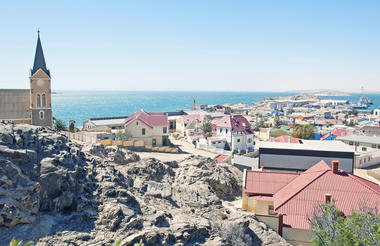
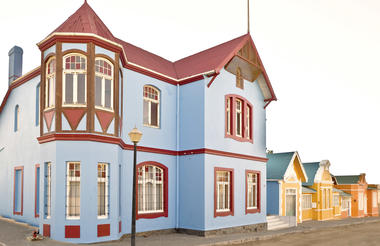
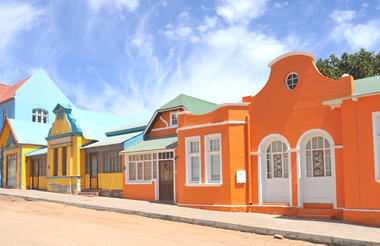
Located in Namib-Naukluft National Park, Sossusvlei is famous for its setting amidst the iconic red dunes of the Namib. The clear blue skies contrasting with the towering dunes make this one of the most scenic natural wonders of Africa and a photographer's dream. At up to 400 metres high, some of the ‘mountains of sand’ are among the highest in the world. In the morning and evening light the dunes come alive with amazing displays of colour that draw photography enthusiasts from around the globe. Sossusvlei is home to a variety of desert wildlife including gemsbok, springbok, ostrich and various reptiles. This awe-inspiring destination is the second-most visited attraction in Namibia.
Optional / Recommended Activities: Climb 'Big Daddy', one of Sossusvlei’s tallest dunes; explore neighbouring Deadvlei, a dazzling white clay pan dotted with ancient fossilised camel thorn trees; take a scenic flight across the Namib Sand Sea or a hot air balloon trip followed by a once-in-a-lifetime champagne breakfast amidst the majestic dunes. (At Extra Cost)
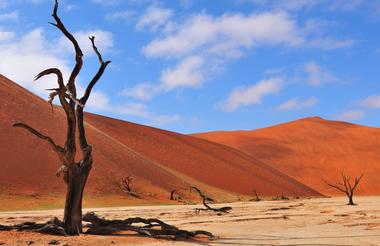
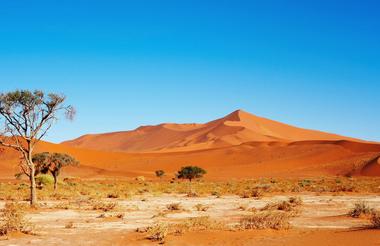

In 1892, eight years after South West Africa was declared a German Protectorate, Swakopmund was founded with the intention to build a harbour. By 1907 a little town pulsating with life had emerged from the desert! Swakopmund boasted the largest European population of all the German colonies in Africa. Decades on and much bigger now, the charming town is as alluring as ever. The mix of Namibian influences with picturesque buildings from the colonial era, palm-lined streets and seaside promenades, the laid-back holiday atmosphere plus the cool sea breeze make Swakopmund one of the most attractive places in the country.
Despite the turquoise waters of the Atlantic Ocean on its doorstep and the Namib Desert as its backyard, Swakopmund is not a tropical sunbathing paradise, however. The moderate climate along the coast is due to the cold Benguela Current. The current also causes the nightly fogs for which the town is famous and which sustain the wealth of desert flora and fauna near the coast. Early mornings and the evenings can be chilly throughout the year – a welcome respite from the inland heat.
Swakopmund has become the country’s adventure mecca. The desert, the dunes and the ocean lend themselves to a host of thrilling activities: sandboarding, sand skiing, quad biking, dune carting, beach angling and deep sea fishing, to name but a few, and not to forget parachuting.
There is no shortage of diverse shops, bistros and restaurants. Small specialist shops sell hand-made leather work, art & crafts, hand-woven carpets and wall hangings, hand-embroidered bed and table linen and other items proudly made in Namibia. Superb jewellery, designed and crafted with local gemstones by master goldsmiths, are another special feature of Swakopmund.
Activities other than fun in the sand and the sea: visit the art galleries and buy contemporary Namibian art and crafts; visit the museum to learn about Swakopmund’s history; join a tour of Karakulia Weavers and watch karakul wool being spun and woven into wall hangings and rugs; admire the world's largest quartz crystal cluster and other mineral treasures at the Kristall Galerie.
